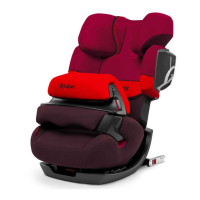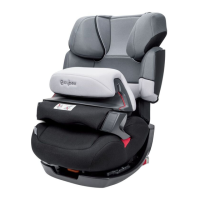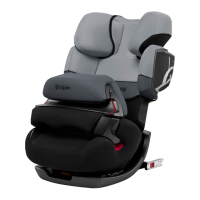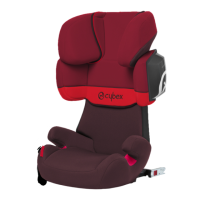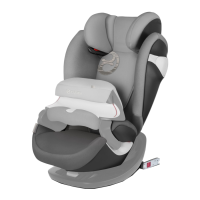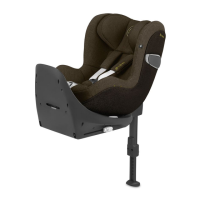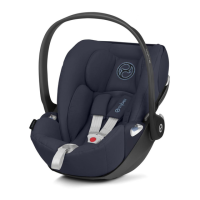COCUGUNUZU EMINIYET KEMERINI KORYUCU PARCASI OLMADAN BAGLAMAK.
Çocugu güvenlik koltuguna oturtun. 3-nokta emniyet kemerini çekip çocugunuzun.
Önündeki kemer yuvasına getirin.
Kemer tokasını (m) yuvaya takın (I). Klik sesiyle kilitlenmesini duyun.
(n) kemerini koltuktaki (k) yuvasından geçirin. Şimdi (f) kemerini çekerek (n) kemerini
gerginleştirin. Kemerler ne kadar gergin olursa koltukta o derece güvenli olacaktır.
Kucak kemeri (n) koltugun (d) alt iki tarafta bulunan (k) yuvalarında olmalı.
Dikkat! Çocugunuza kemerin her zaman gergin olması gerektiğini ve kemeri nasıl
gerginleştirecegini öğretin.
Uyarı! Kemeri Kıvırmayın!
Uyarı! Koltuktaki (I) kemer tokası hiç bir şekilde alttaki (k) yuvasına ulaşmamalıdır.
Kemer uzun kalıyorsa bu araç için koltuk uygun değildir.
Uyarı! Kucak kemeri, her iki tarata da çocugunuzun kalçasının mümkün
oldugunca yakınında olmalıdır.
Çapraz kemeri (f) omuz dayamanın içindeki (e) üst kırmızı kemer yuvasına (g) içine
girecek şekilde getirin.
Çapraz kemerin (f) çocugunuzun omzunun dış kenarı ile boynu arasında oldugunu
görün. Gerekirse kafalığın yüksekliğini ayarlayarak kemerin rahatca hareketini
saglayın. Kafalıgın yüksekliği aracın içinde de ayarlanabilir.
Çocugunuzun güvenliği için lütfen dikkat edin:
– Kucak kemeri (n) alttaki her iki yuvalarda (k) olmalı.
– çapraz kemer (f) ayrıca kemer tokasının yan tarafındaki alt kemer yuvasında olmalı
(k)
– çapraz kemer (f) omuz korumasındaki kırmızı kemer yuvasında olmalı (g)
– koltuk kemer (f) çapraz olarak geriye gitmeli
– tüm kemerler gergin ve kıvrılmamış olmalı.
ÇOCUGUNUZ TAMAMIYLA GÜVENDE MI?
54
Warning! The lap belt must, on both sides, run as low across the groin of your child as
possible in order to take optimal effect in case of an accident.
Now lead the diagonal belt (f) through the upper red belt guide (g) in the
shoulder rest (e) until it is inside the belt guide.
Please make sure that the diagonal belt (f) runs between the outer edge of the
shoulder and your child‘s neck. If necessary, adjust the running of the belt by
adjusting the height of the headrest. The height of the headrest can still be adjusted
in the car.
SECURING THE CHILD WITHOUT CRASH PILLOW
Put your child in the child seat. Pull out the three-point belt and lead it in front of your
child to the belt buckle (l).
Warning! Never twist the belt!
Put the belt guide (m) into the belt buckle (l). If you hear a clicking sound it is securely
locked.
The lap belt (n) should be placed in the bottom belt guides (k) on both sides of the
seat (d).
Note! Teach your child from the beginning to always pay attention to a tight belt and
that it should pull the belt tight by itself if necessary.
Put the lap belt (n) in the bottom belt guides (k) of the child seat. Now pull the lap
belt (n) tight by pulling the diagonal belt (f) until there is no slack. The tighter the belt
the better it can protect from injuries. The diagonal belt and lap belt should both be
inserted in the bottom belt guide at the side of the belt buckle.
Warning! The belt buckle of the car seat (l) must under no circumstances
reach into the bottom belt guide (k). If the belt strap is too long, the child seat is not
suitable for this vehicle.
In order to guarantee the best possible safety for your child, please check prior to
the ride, whether …
– the lap belt (n) runs in the bottom belt guides (k) on both sides of the child seat.
– the diagonal belt (f) also runs in the bottom belt guide (k) of the child seat on the
side of the belt buckle.
– the diagonal belt (f) runs through the belt guide (g) of the shoulder rest, marked
red
– the seat belt (f) runs diagonally towards the back.
– the entire belt sits tight and is not twisted.
IS YOUR CHILD PROPERLY SECURED?
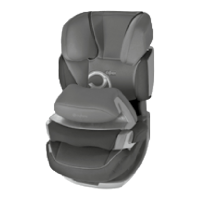
